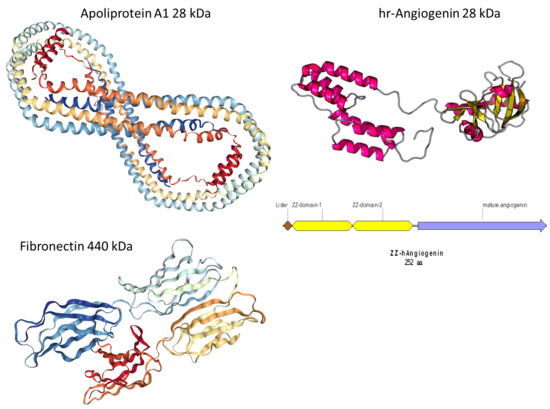XPS Modeling of Immobilized Recombinant Angiogenin and Apoliprotein A1 on Biodegradable Nanofibers
Abstract
1. Introduction
2. Materials and Methods
2.1. Electrospining of Nanofibers
2.2. Deposition of COOH Plasma Layer
2.3. Synthesis of Proteins
2.4. Immobilization of Proteins
2.5. Measurement of Protein Concentration
2.6. Characterization of Samples
3. Results
3.1. Immobilization of Proteins onto PCL-ref by Adsorption
3.2. Immobilization of Proteins onto PCL-COOH by Covalent Linkage
3.3. Analysis of Immobilized Proteins by the Fluorescence Microscopy
3.4. Modeling of the XPS C1s Spectra of Proteins and Layers
4. Discussion
- The functional groups of proteins can be hindered by the interaction with the substrate or “neighbors”, and thus the real spectra of pure protein for x = 1 might provide a better convergence;
- The interaction of the COOH groups and EDC requires more careful investigation;
- Further validation of the proposed methodology should be performed.
5. Conclusions
Supplementary Materials
Author Contributions
Funding
Acknowledgments
Conflicts of Interest
References
- DeFrates, K.G.; Moore, R.; Borgesi, J.; Lin, G.; Mulderig, T.; Beachley, V.; Hu, X. Protein-Based Fiber Materials in Medicine: A Review. Nanomaterials 2018, 8, 457. [Google Scholar] [CrossRef] [PubMed]
- Manakhov, A.M.; Landová, M.; Medalová, J.; Michlicek, M.; Polčak, J.; Nečas, D.; Zajíčková, L. Cyclopropylamine plasma polymers for increased cell adhesion and growth. Plasma Process. Polym. 2016, 14, 1600123. [Google Scholar] [CrossRef]
- Solovieva, A.; Miroshnichenko, S.; Kovalskii, A.M.; Permyakova, E.S.; Popov, Z.; Dvořáková, E.; Kiryukhantsev-Korneev, F.V.; Obrosov, A.; Polčak, J.; Zajíčková, L.; et al. Immobilization of Platelet-Rich Plasma onto COOH Plasma-Coated PCL Nanofibers Boost Viability and Proliferation of Human Mesenchymal Stem Cells. Polymer 2017, 9, 736. [Google Scholar] [CrossRef] [PubMed]
- Yang, W.; Zhang, X.; Wu, K.; Liu, X.; Jiao, Y.; Zhou, C. Improving cytoactive of endothelial cell by introducing fibronectin to the surface of poly L-Lactic acid fiber mats via dopamine. Mater. Sci. Eng. C 2016, 69, 373–379. [Google Scholar] [CrossRef]
- Zhang, Z.; Yoo, R.; Wells, M.; Beebe, T.P.; Biran, R.; Tresco, P. Neurite outgrowth on well-characterized surfaces: Preparation and characterization of chemically and spatially controlled fibronectin and RGD substrates with good bioactivity. Biomaterials 2005, 26, 47–61. [Google Scholar] [CrossRef]
- Aparicio, I.; Prehn, J.H.M. Molecular Mechanisms in Amyotrophic Lateral Sclerosis: The Role of Angiogenin, a Secreted RNase. Front. Mol. Neurosci. 2012, 6, 1–7. [Google Scholar] [CrossRef]
- Hoang, T.T.; Johnson, D.A.; Raines, R.T.; Johnson, J.A. Angiogenin activates the astrocytic Nrf2/antioxidant-response element pathway and thereby protects murine neurons from oxidative stress. J. Biol. Chem. 2019, 294, 15095–15103. [Google Scholar] [CrossRef]
- Lee, S.H.; Kim, K.W.; Joo, K.; Kim, J. Angiogenin ameliorates corneal opacity and neovascularization via regulating immune response in corneal fibroblasts. BMC Ophthalmol. 2016, 16, 57. [Google Scholar] [CrossRef] [PubMed]
- Osorio, D.S.; Antunes, A.; Ramos, M.J. Structural and functional implications of positive selection at the primate angiogenin gene. BMC Evol. Boil. 2007, 7, 167. [Google Scholar] [CrossRef]
- Hooper, L.V.; Stappenbeck, T.S.; Hong, C.V.; Gordon, J.I. Angiogenins: A new class of microbicidal proteins involved in innate immunity. Nat. Immunol. 2003, 4, 269–273. [Google Scholar] [CrossRef]
- Brites, F.; Martin, M.; Guillas, I.; Kontush, A. Antioxidative activity of high-density lipoprotein (HDL): Mechanistic insights into potential clinical benefit. BBA Clin. 2017, 8, 66–77. [Google Scholar] [CrossRef] [PubMed]
- Castaing-Berthou, A.; Malet, N.; Radojkovic, C.; Cabou, C.; Gayral, S.; O Martinez, L.; Laffargue, M. PI3Kβ Plays a Key Role in Apolipoprotein A-I-Induced Endothelial Cell Proliferation Through Activation of the Ecto-F1-ATPase/P2Y1 Receptors. Cell. Physiol. Biochem. 2017, 42, 579–593. [Google Scholar] [CrossRef]
- Hyka, N.; Dayer, J.-M.; Modoux, C.; Kohno, T.; Edwards, C.K.; Roux-Lombard, P.; Burger, D. Apolipoprotein A-I inhibits the production of interleukin-1β and tumor necrosis factor-α by blocking contact-mediated activation of monocytes by T lymphocytes. Blood 2001, 97, 2381–2389. [Google Scholar] [CrossRef] [PubMed]
- Blackburn, W.D.; Dohlman, J.G.; Venkatachalapathi, Y.V.; Pillion, D.J.; Koopman, W.J.; Segrest, J.P.; Anantharamaiah, G.M. Apolipoprotein A-I decreases neutrophiI degranulation and superoxide production. J. Lipid Res. 1991, 32, 1911–1918. [Google Scholar] [PubMed]
- Srinivas, R.; Birkedal, B.; Owens, R.; Anantharamaiah, G.; Segrest, J.; Compans, R. Antiviral effects of apolipoprotein A-I and its synthetic amphipathic peptide analogs. Virology 1990, 176, 48–57. [Google Scholar] [CrossRef]
- Burgess, J.W.; Kiss, R.S.; Zheng, H.; Zachariah, S.; Marcel, Y.L. Trypsin-sensitive and lipid-containing sites of the macrophage extracellular matrix bind apolipoprotein A-I and participate in ABCA1-dependent cholesterol effiux efflux. J. Biol. Chem. 2002, 277, 31318–31326. [Google Scholar] [CrossRef]
- Segrest, J.P.; Jones, M.K.; De Loof, H.; Brouillette, C.G.; Venkatachalapathi, Y.V.; Anantharamaiah, G.M. The amphipathic helix in the exchangeable apolipoproteins: A review of secondary structure and function. J. Lipid Res. 1992, 33, 141–166. [Google Scholar]
- Gonzalez, M.; Toledo, J.D.; Tricerri, M.A.; Garda, H.A. The central type Y amphipathic α-helices of apolipoprotein AI are involved in the mobilization of intracellular cholesterol depots. Arch. Biochem. Biophys. 2008, 473, 34–41. [Google Scholar] [CrossRef]
- Vo¨lcker, N.; Klee, D.; Höcker, H.; Langefeld, S. Functionalization of silicone rubber for the covalent immobilization of fibronectin. J. Mater. Sci. Mater. Electron. 2001, 12, 111–119. [Google Scholar] [CrossRef]
- Nagai, M.; Hayakawa, T.; Makimura, M.; Yoshinari, M. Fibronectin Immobilization using Water-soluble Carbodiimide on Poly-L-lactic Acid for Enhancing Initial Fibroblast Attachment. J. Biomater. Appl. 2006, 21, 33–47. [Google Scholar] [CrossRef]
- Liverani, L.; Boccaccini, A. Versatile Production of Poly(Epsilon-Caprolactone) Fibers by Electrospinning Using Benign Solvents. Nanomaterials 2016, 6, 75. [Google Scholar] [CrossRef] [PubMed]
- Al-Enizi, A.M.; Zagho, M.M.; Elzatahry, A.A. Polymer-Based Electrospun Nanofibers for Biomedical Applications. Nanomaterials 2018, 8, 259. [Google Scholar] [CrossRef] [PubMed]
- Salević, A.; Prieto, C.; Cabedo, L.; Nedović, V.; Lagaron, J.M. Physicochemical, Antioxidant and Antimicrobial Properties of Electrospun Poly(ε-caprolactone) Films Containing a Solid Dispersion of Sage (Salvia officinalis L.) Extract. Nanomaterials 2019, 9, 270. [Google Scholar] [CrossRef]
- Permyakova, E.S.; Polčak, J.; Slukin, P.V.; Ignatov, S.; Gloushankova, N.A.; Zajíčková, L.; Shtansky, D.V.; Manakhov, A.M. Antibacterial biocompatible PCL nanofibers modified by COOH-anhydride plasma polymers and gentamicin immobilization. Mater. Des. 2018, 153, 60–70. [Google Scholar] [CrossRef]
- Manakhov, A.M.; Kedroňová, E.; Medalová, J.; Černochová, P.; Obrusník, A.; Michlicek, M.; Shtansky, D.V.; Zajíčková, L. Carboxyl-anhydride and amine plasma coating of PCL nanofibers to improve their bioactivity. Mater. Des. 2017, 132, 257–265. [Google Scholar] [CrossRef]
- Pykhtina, M.B.; Ivanov, I.D.; Beklemishev, A.B. Development of effective ways of apolipoprotein A-I isolation from human plasma. Russ. J. Biopharm. 2012, 4, 37–45. [Google Scholar]
- Ramazanov, Y.A.; Beklemishev, A.B. Artificial Gene, Coding Cimeric Protein of Human Angiogenin, Chimeric Plasmid Pjzz-a, Ensuring Expression of Gene of Chimeric Protein of Human Angiogenin in Escherichia coli and Strain of Escherichia coli bl21(de3)/pjzz-a-producent of Recombinant Chimeric Protein of Human Angiogenin. Available online: https://russianpatents.com/patent/251/2512527.html (accessed on 29 April 2020).
- Beamson, G.; Briggs, D. High Resolution XPS of Organic Polymers; John Wiley & Sons: Chichester, UK, 1992. [Google Scholar]
- Stevens, J.S.; De Luca, A.C.; Pelendritis, M.; Terenghi, G.; Downes, S.; Schroeder, S.L.M. Quantitative analysis of complex amino acids and RGD peptides by X-ray photoelectron spectroscopy (XPS). Surf. Interface Anal. 2013, 45, 1238–1246. [Google Scholar] [CrossRef]
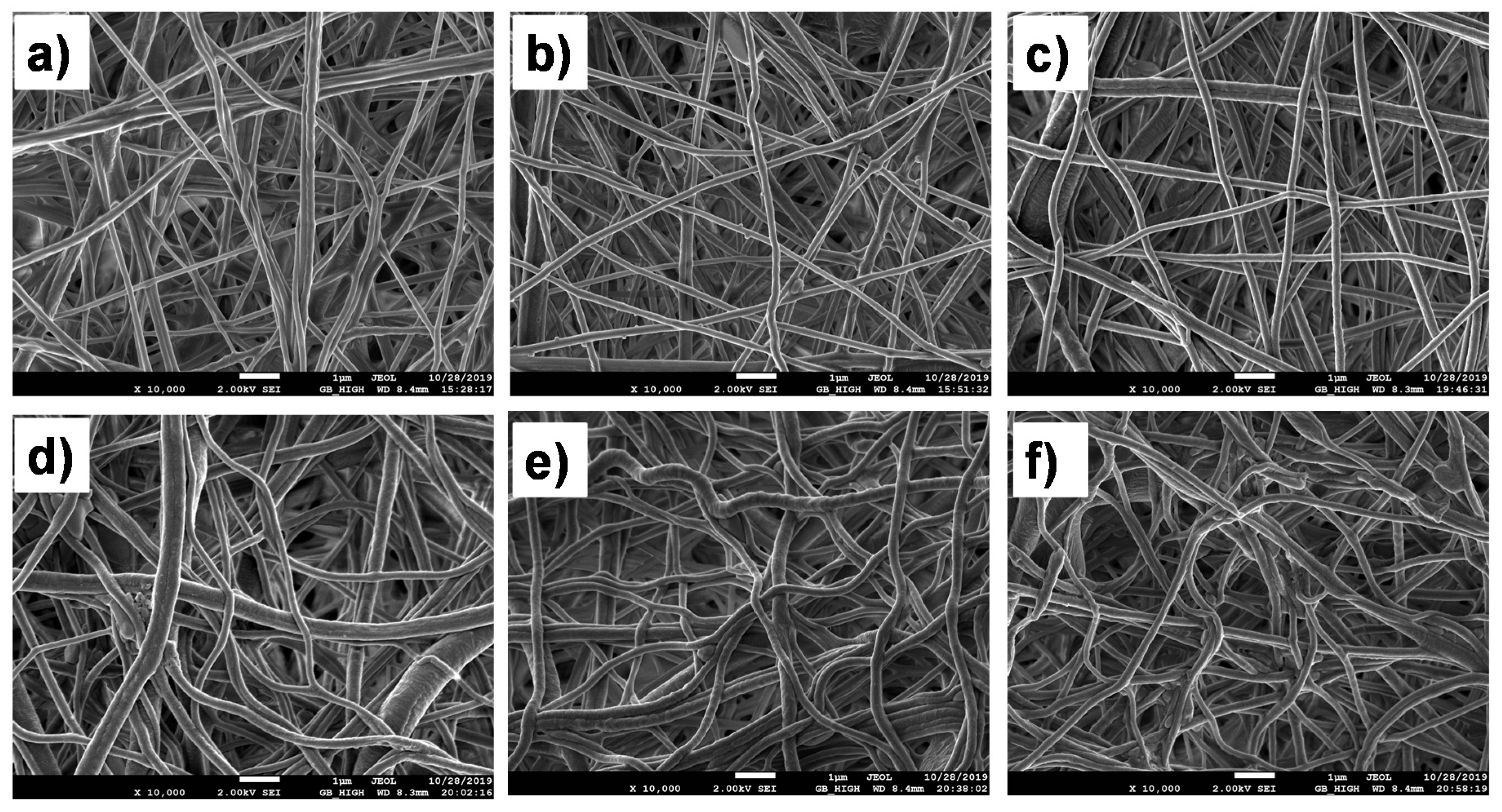
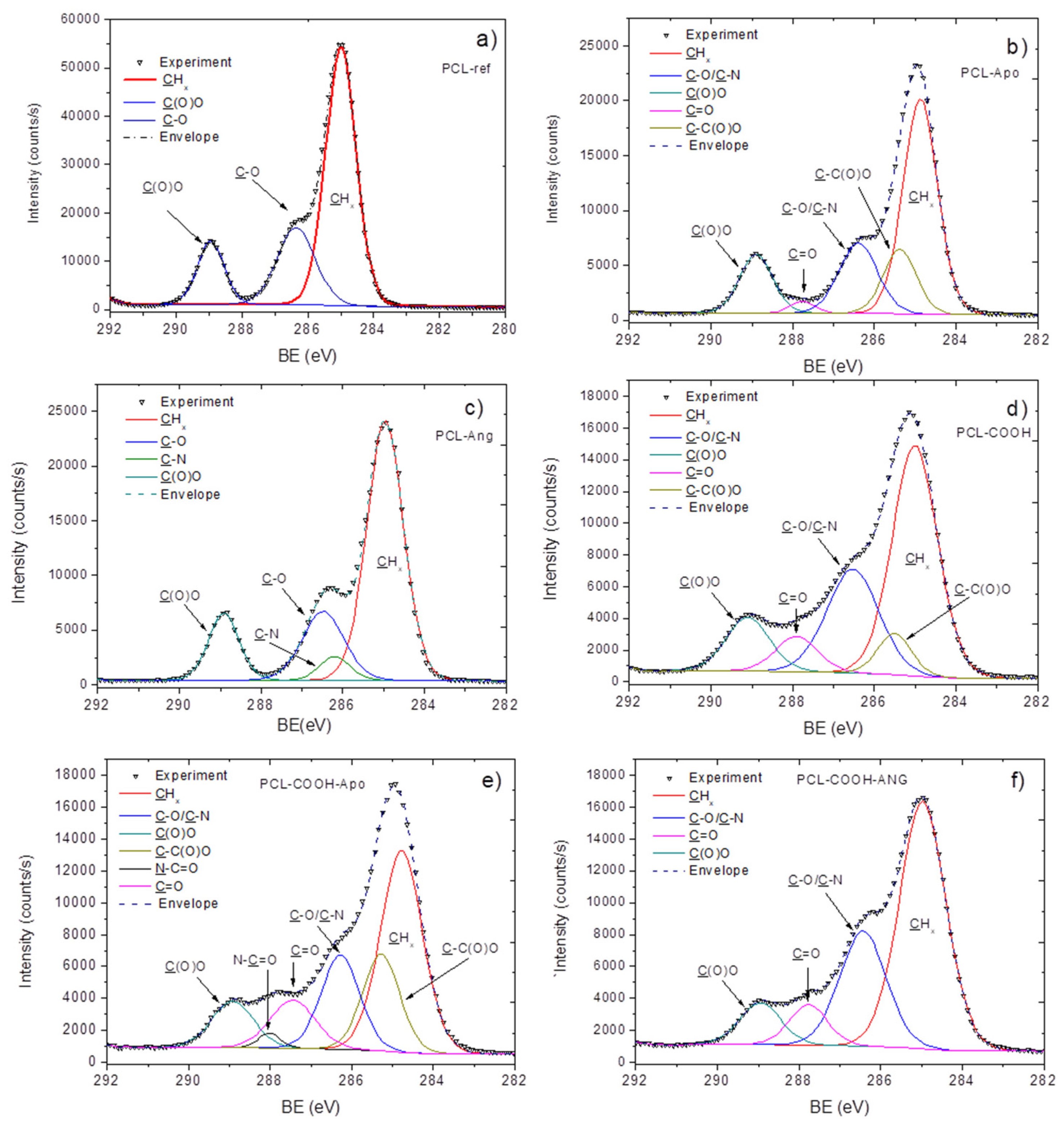
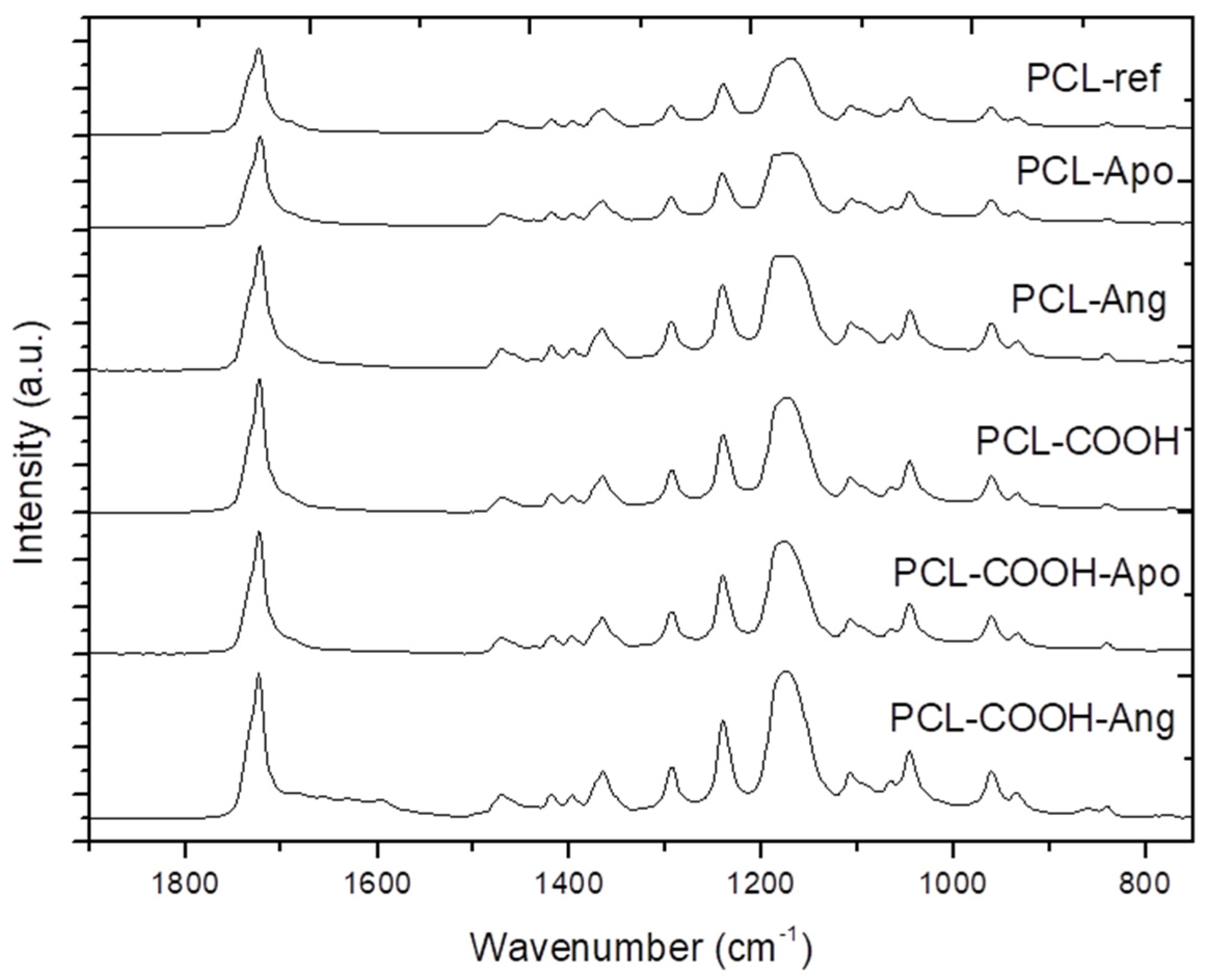

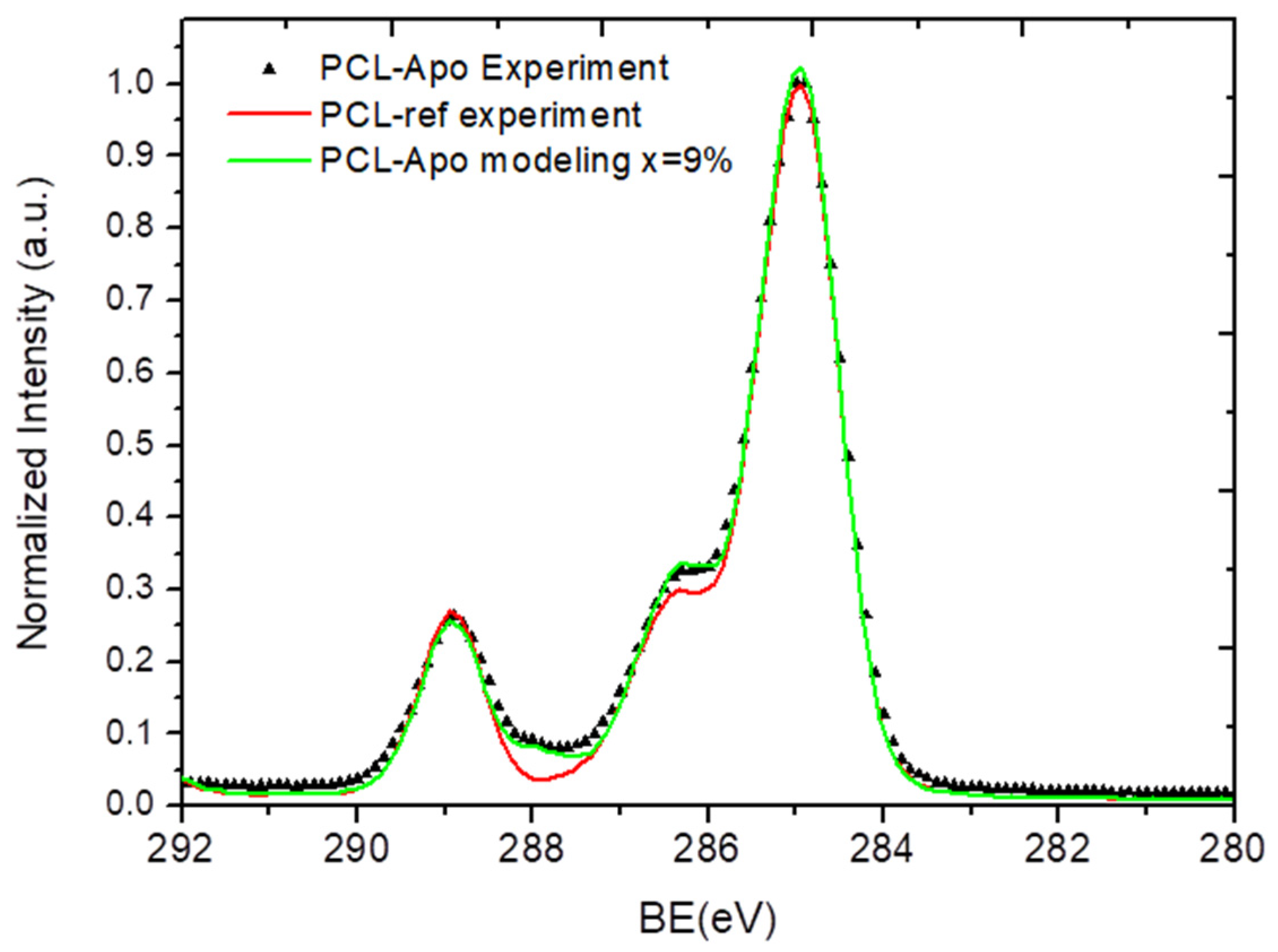
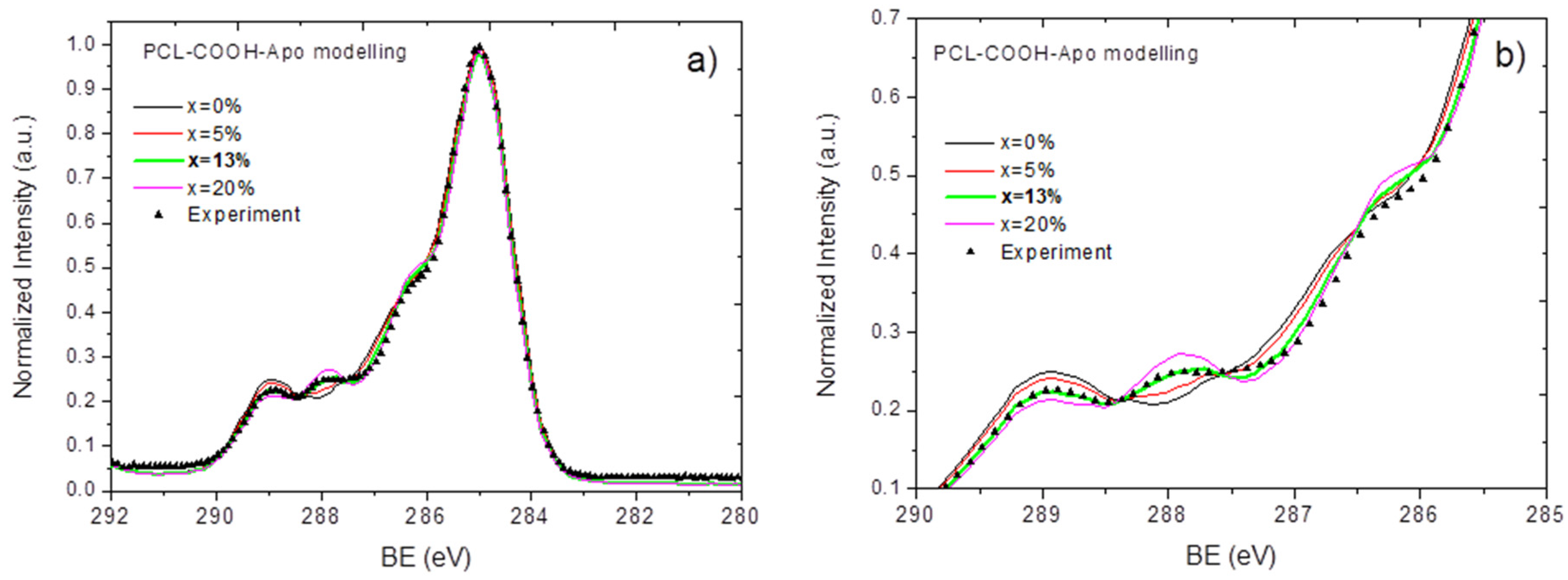
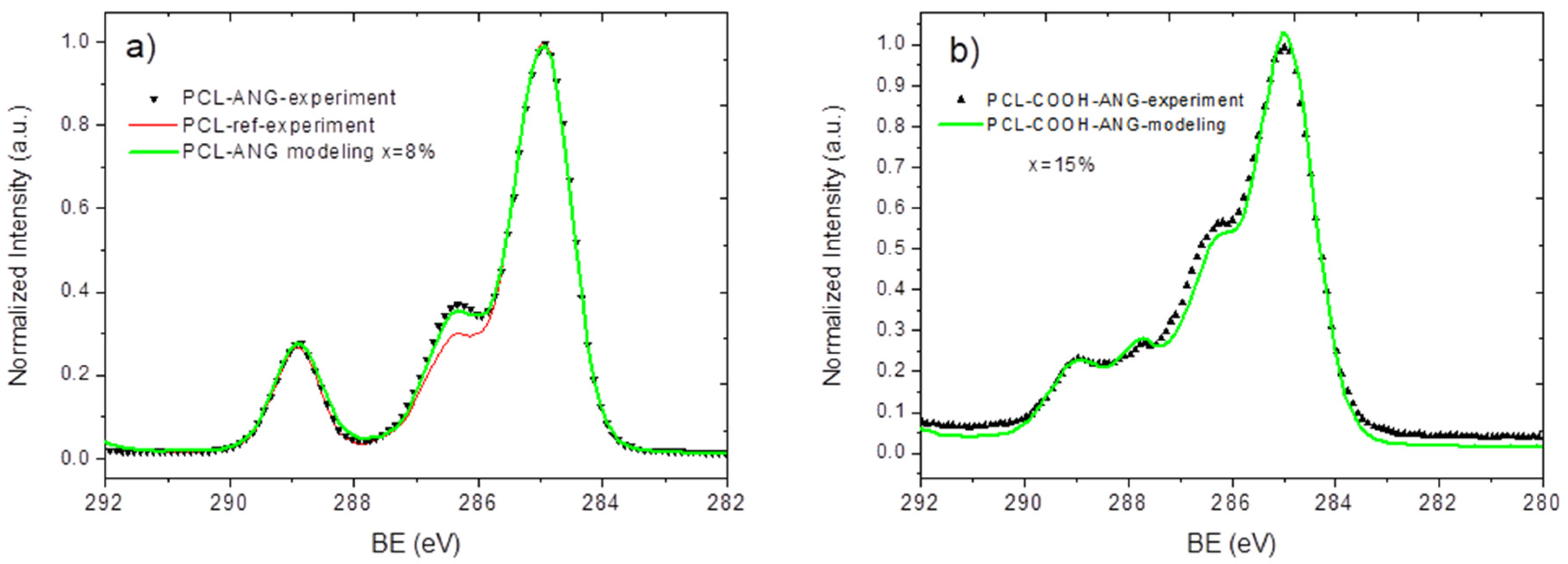
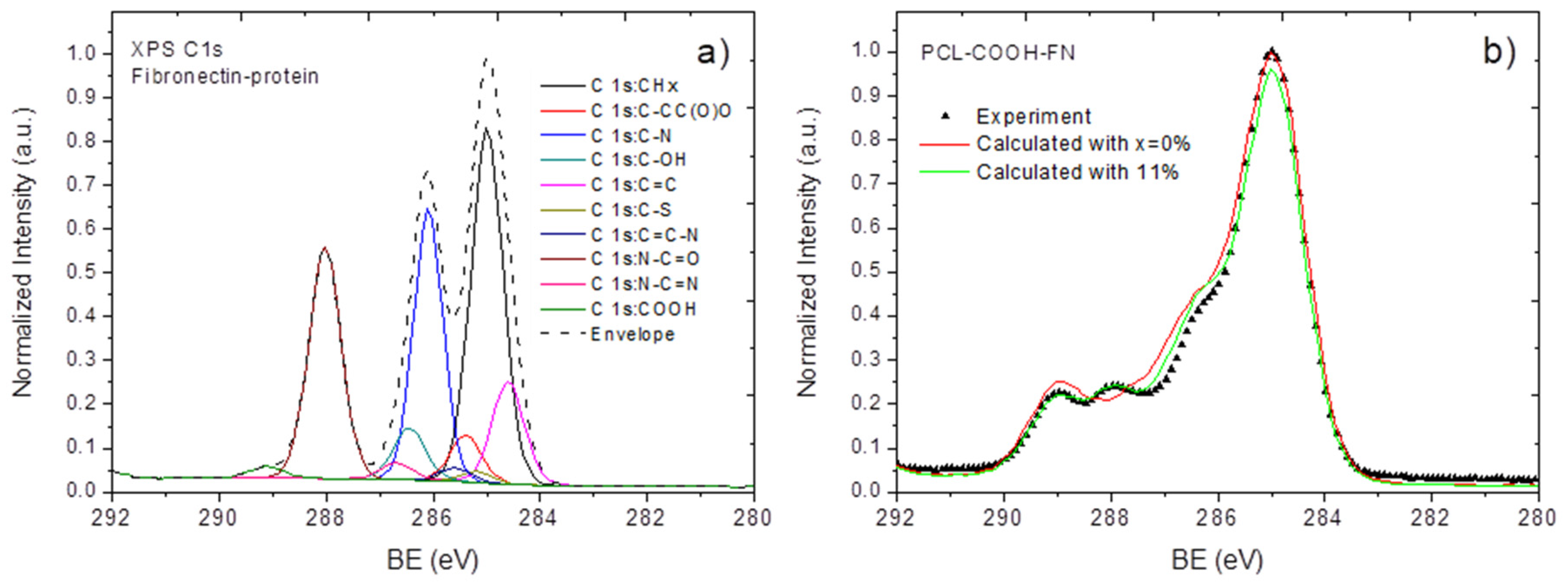
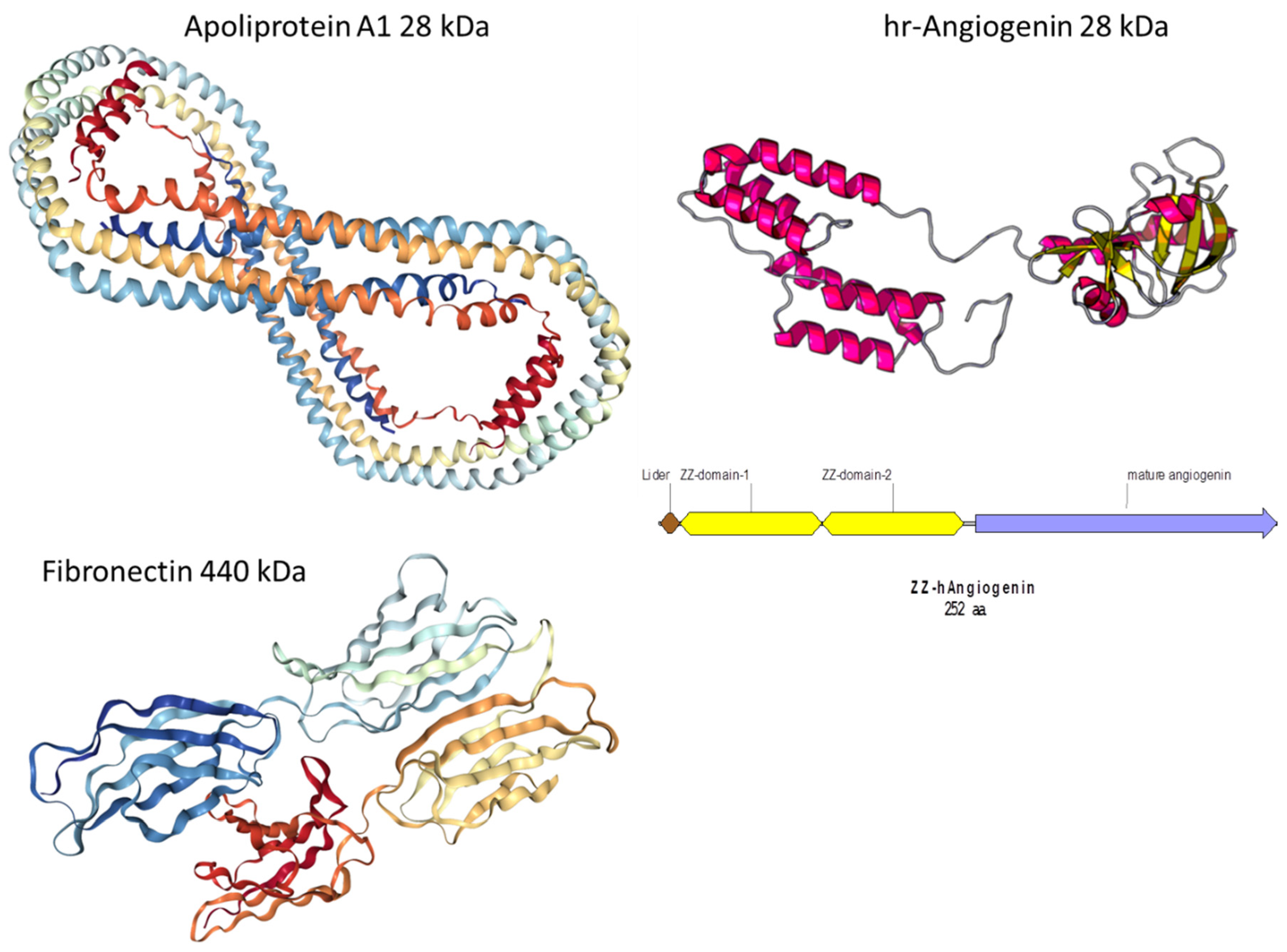
| Sample Name | [C], at.% | [O], at.% | [N], at.% |
|---|---|---|---|
| PCL-ref | 73.9 | 26.1 | 0.0 |
| PCL-APO | 75.8 | 22.0 | 2.2 |
| PCL-ANG | 78.0 | 22.0 | 0.0 |
| PCL-COOH | 72.3 | 27.5 | 0.3 |
| PCL-COOH-APO | 72.6 | 24.5 | 2.9 |
| PCL-COOH-ANG | 72.4 | 26.5 | 1.1 |
| PCL-COOH-FN | 71.3 | 23.1 | 5.6 |
© 2020 by the authors. Licensee MDPI, Basel, Switzerland. This article is an open access article distributed under the terms and conditions of the Creative Commons Attribution (CC BY) license (http://creativecommons.org/licenses/by/4.0/).
Share and Cite
Manakhov, A.; Permyakova, E.; Ershov, S.; Miroshnichenko, S.; Pykhtina, M.; Beklemishev, A.; Kovalskii, A.; Solovieva, A. XPS Modeling of Immobilized Recombinant Angiogenin and Apoliprotein A1 on Biodegradable Nanofibers. Nanomaterials 2020, 10, 879. https://doi.org/10.3390/nano10050879
Manakhov A, Permyakova E, Ershov S, Miroshnichenko S, Pykhtina M, Beklemishev A, Kovalskii A, Solovieva A. XPS Modeling of Immobilized Recombinant Angiogenin and Apoliprotein A1 on Biodegradable Nanofibers. Nanomaterials. 2020; 10(5):879. https://doi.org/10.3390/nano10050879
Chicago/Turabian StyleManakhov, Anton, Elizaveta Permyakova, Sergey Ershov, Svetlana Miroshnichenko, Mariya Pykhtina, Anatoly Beklemishev, Andrey Kovalskii, and Anastasiya Solovieva. 2020. "XPS Modeling of Immobilized Recombinant Angiogenin and Apoliprotein A1 on Biodegradable Nanofibers" Nanomaterials 10, no. 5: 879. https://doi.org/10.3390/nano10050879
APA StyleManakhov, A., Permyakova, E., Ershov, S., Miroshnichenko, S., Pykhtina, M., Beklemishev, A., Kovalskii, A., & Solovieva, A. (2020). XPS Modeling of Immobilized Recombinant Angiogenin and Apoliprotein A1 on Biodegradable Nanofibers. Nanomaterials, 10(5), 879. https://doi.org/10.3390/nano10050879







